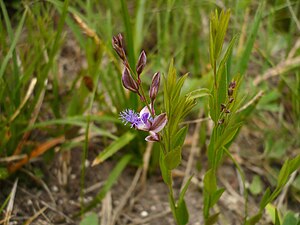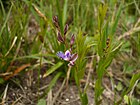Note: This is a project under development. The articles on this wiki are just being initiated and broadly incomplete. You can Help creating new pages.
Difference between revisions of "Polygala sibirica"
(Created page with "{{stub}} ==Uses== {{Uses|}}, {{Uses|}}, {{Uses|}}, {{Uses|}}, {{Uses|}}, {{Uses|}}, {{Uses|}}, {{Uses|}}, {{Uses|}}, {{Uses|}}, {{Uses|}}.<ref name="Uses"/> ==Parts Used== {{...") |
|||
| (One intermediate revision by the same user not shown) | |||
| Line 1: | Line 1: | ||
| − | + | [[File:Истод сибирский KR 02.jpg|thumb|right]] | |
| + | '''Polygala sibirica''' is a perennial plant that can grow up to 0.15 metres tall. It is harvested from the wild for local use as a food and medicine | ||
==Uses== | ==Uses== | ||
| − | {{Uses|}}, {{Uses|}}, {{Uses|}}, {{Uses|}}, {{Uses|}}, {{Uses|}}, {{Uses|}}, {{Uses| | + | {{Uses|Spermatorrhoea}}, {{Uses|Blood pressure}}, {{Uses|Coughs}}, {{Uses|Bronchitis}}, {{Uses|Insomnia}}, {{Uses|Infantile convulsions}}, {{Uses|Amnesia}}, {{Uses|Sexual impotency}}.<ref name="Uses"/> |
==Parts Used== | ==Parts Used== | ||
| − | {{Parts Used| | + | {{Parts Used|Young leaves}}, {{Parts Used|Roots}}. |
==Chemical Composition== | ==Chemical Composition== | ||
| − | <ref name="chemical composition"/> | + | It contains dimethoxyacetophenone, Evofolin, Salicylic acid, Trans-sinapic acid methyl ester, Trimethoxycinnamic acid methyl ester, Trimethoxycinnamic acid, Hydroxy, Trimethoxy-flavone, Sinapylalcohol-4-O-β-D-apiofuranosyl-(1→2)-β-D-glucopyranoside, Syringaresinol, Medioresinol, Pinoresinol.<ref name="chemical composition"/> |
==Common names== | ==Common names== | ||
| Line 16: | Line 17: | ||
===Dravya=== | ===Dravya=== | ||
===Rasa=== | ===Rasa=== | ||
| − | |||
===Guna=== | ===Guna=== | ||
| Line 29: | Line 29: | ||
==Habit== | ==Habit== | ||
| − | {{Habit|}} | + | {{Habit|Perennial}} |
==Identification== | ==Identification== | ||
| Line 48: | Line 48: | ||
==Mode of Propagation== | ==Mode of Propagation== | ||
| − | {{Propagation|}} | + | {{Propagation|Seeds}}, {{Propagation|Cuttings of young shoots}}. |
==How to plant/cultivate== | ==How to plant/cultivate== | ||
| − | <ref name="How to plant/cultivate"/> | + | We have very little information on this species and do not know if it will be hardy in Britain, though judging by its native range it should succeed outdoors in most parts of this country. It is a very variable plant.<ref name="How to plant/cultivate"/> |
==Commonly seen growing in areas== | ==Commonly seen growing in areas== | ||
| − | {{Commonly seen|}}, {{Commonly seen| | + | {{Commonly seen|Open slopes in the Himalayas}}, {{Commonly seen|Dry calcareous slopes}}. |
==Photo Gallery== | ==Photo Gallery== | ||
<gallery class="left" caption="" widths="140px" heights="140px"> | <gallery class="left" caption="" widths="140px" heights="140px"> | ||
| − | + | Истод сибирский KR 01.jpg | |
| + | Истод сибирский KR 02.jpg | ||
| + | Истод сибирский KR 04.jpg | ||
| + | Истод сибирский Альбом KR 03.jpg | ||
</gallery> | </gallery> | ||
| Line 64: | Line 67: | ||
<references> | <references> | ||
| − | <ref name="chemical composition">[ | + | <ref name="chemical composition">[https://www.researchgate.net/publication/322151056_Chemical_constituents_of_Polygala_sibirica_L_var_megalopha_Fr Chemical constituents]</ref> |
| − | <ref name="Leaf">[ | + | <ref name="Leaf">[Morphology]</ref> |
| − | <ref name="How to plant/cultivate">[ | + | <ref name="How to plant/cultivate">[http://temperate.theferns.info/plant/Polygala+sibirica Cultivation]</ref> |
<ref name="Uses">Indian Medicinal Plants by C.P.Khare</ref> | <ref name="Uses">Indian Medicinal Plants by C.P.Khare</ref> | ||
</references> | </references> | ||
==External Links== | ==External Links== | ||
| − | * [ ] | + | * [https://www.flowersofindia.net/catalog/slides/Siberian%20Milkwort.html Polygala sibirica on wikimedia commons] |
| − | + | ||
| − | |||
[[Category:Herbs]] | [[Category:Herbs]] | ||
| + | [[Category:Pages without herbs images]] | ||
Latest revision as of 11:19, 8 July 2020
Polygala sibirica is a perennial plant that can grow up to 0.15 metres tall. It is harvested from the wild for local use as a food and medicine
Contents
- 1 Uses
- 2 Parts Used
- 3 Chemical Composition
- 4 Common names
- 5 Properties
- 6 Habit
- 7 Identification
- 8 List of Ayurvedic medicine in which the herb is used
- 9 Where to get the saplings
- 10 Mode of Propagation
- 11 How to plant/cultivate
- 12 Commonly seen growing in areas
- 13 Photo Gallery
- 14 References
- 15 External Links
Uses
Spermatorrhoea, Blood pressure, Coughs, Bronchitis, Insomnia, Infantile convulsions, Amnesia, Sexual impotency.[1]
Parts Used
Chemical Composition
It contains dimethoxyacetophenone, Evofolin, Salicylic acid, Trans-sinapic acid methyl ester, Trimethoxycinnamic acid methyl ester, Trimethoxycinnamic acid, Hydroxy, Trimethoxy-flavone, Sinapylalcohol-4-O-β-D-apiofuranosyl-(1→2)-β-D-glucopyranoside, Syringaresinol, Medioresinol, Pinoresinol.[2]
Common names
| Language | Common name |
|---|---|
| Kannada | |
| Hindi | |
| Malayalam | |
| Tamil | |
| Telugu | |
| Marathi | |
| Gujarathi | |
| Punjabi | |
| Kashmiri | |
| Sanskrit | |
| English |
Properties
Reference: Dravya - Substance, Rasa - Taste, Guna - Qualities, Veerya - Potency, Vipaka - Post-digesion effect, Karma - Pharmacological activity, Prabhava - Therepeutics.
Dravya
Rasa
Guna
Veerya
Vipaka
Karma
Prabhava
Habit
Identification
Leaf
| Kind | Shape | Feature |
|---|---|---|
Flower
| Type | Size | Color and composition | Stamen | More information |
|---|---|---|---|---|
| {{{5}}} |
Fruit
| Type | Size | Mass | Appearance | Seeds | More information |
|---|---|---|---|---|---|
Other features
List of Ayurvedic medicine in which the herb is used
Where to get the saplings
Mode of Propagation
Seeds, Cuttings of young shoots.
How to plant/cultivate
We have very little information on this species and do not know if it will be hardy in Britain, though judging by its native range it should succeed outdoors in most parts of this country. It is a very variable plant.[4]
Commonly seen growing in areas
Open slopes in the Himalayas, Dry calcareous slopes.
Photo Gallery
References
- ↑ Indian Medicinal Plants by C.P.Khare
- ↑ Chemical constituents
- ↑ [Morphology]
- ↑ Cultivation
External Links
- Ayurvedic Herbs known to be helpful to treat Spermatorrhoea
- Ayurvedic Herbs known to be helpful to treat Blood pressure
- Ayurvedic Herbs known to be helpful to treat Coughs
- Ayurvedic Herbs known to be helpful to treat Bronchitis
- Ayurvedic Herbs known to be helpful to treat Insomnia
- Ayurvedic Herbs known to be helpful to treat Infantile convulsions
- Ayurvedic Herbs known to be helpful to treat Amnesia
- Ayurvedic Herbs known to be helpful to treat Sexual impotency
- Herbs with Young leaves used in medicine
- Herbs with Roots used in medicine
- Habit - Perennial
- Index of Plants which can be propagated by Seeds
- Index of Plants which can be propagated by Cuttings of young shoots
- Herbs that are commonly seen in the region of Open slopes in the Himalayas
- Herbs that are commonly seen in the region of Dry calcareous slopes
- Herbs
- Pages without herbs images




